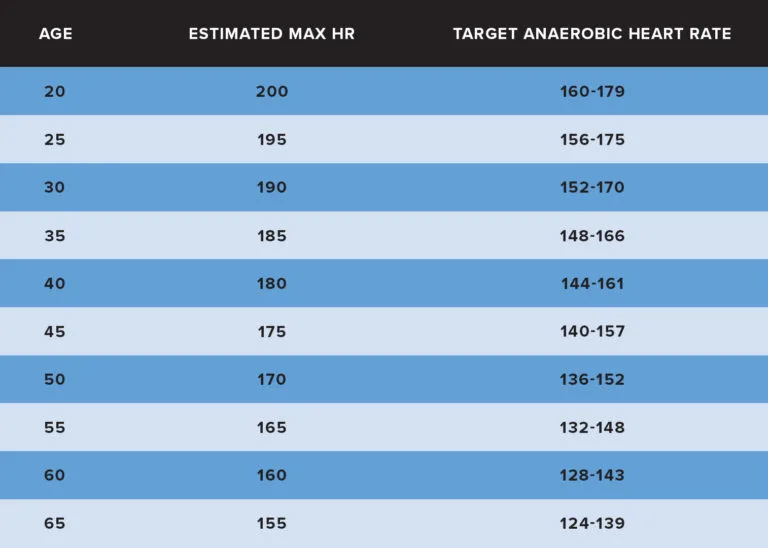Topics
- Article
- Heart Rate
- Training & Exercise
Target the Anaerobic Heart Rate Zone: Benefits and Exercise

Training in the anaerobic heart rate zone can help you build muscles and strengthen your heart.
Getting the most out of every workout does not mean going at full speed until you collapse. Instead, it consists of planning workouts and targeting a specific heart rate to meet your goals. If your goal is to build muscle, targeting the anaerobic heart rate zone should be part of your exercise plan.
What Is The Anaerobic Heart Rate Zone?
Anaerobic means “without oxygen.” It’s a heart rate between 80%-90% of your maximum heart rate. In this heart rate zone, your body can’t get enough oxygen to fuel muscles, so it turns to the glucose found in carbs. The body burns carbs quickly producing lactic acid, but it has a hard time clearing the lactic acid. You may feel your muscles ache during anaerobic routines as lactic acid builds up. Anaerobic workouts like sprinting and weightlifting are more intense but generally shorter in duration than aerobic exercises. You use smaller muscle groups in this zone and usually focus on one muscle group at a time in each activity.
9 Benefits of Anaerobic Exercise
Anaerobic training has been shown to have several physical and psychological benefits, including boosting your mood and reducing your risk of heart disease and diabetes. Here are the top 9 benefits.
1. Build muscle
The first benefit you may notice is larger muscles. Working your muscles causes small tears in the fibers that are reformed to build and strengthen them.
2. Support weight loss
Larger muscles need more calories to function. This means you’ll burn more calories even while resting. This metabolic boost may help you reduce body fat and lose weight.
3. Afterburn
Your body requires a lot of oxygen after an anaerobic workout. This deficit is called excess post-exercise oxygen consumption, aka the afterburn effect, which is the amount of oxygen needed to return the body to its resting state. Since you consume more oxygen during anaerobic sessions than you inhale, you’ll continue to burn more calories even after finishing an activity as you catch your breath.
4. Increase lactate threshold
Lactate or anaerobic threshold is the intensity of exercise at which lactate, or lactic acid, accumulates faster than it can be removed. Training in the anaerobic zone raises the lactate threshold by increasing the muscles' alkaline reserves, allowing them to work in the presence of increased lactic acid. This means that as you continue working in this zone, you’ll be able to train for longer periods of time without suffering the effects of lactic acid buildup.
5. Fight depression
Any exercise can help boost mood and relieve anxiety. While it may not be enough to relieve all the symptoms of depression, high-intensity exercise releases endorphins, dopamine and serotonin, which can reduce depression symptoms.
6. May reduce risk of chronic disease
Anaerobic workouts improve blood glucose control and help the body use insulin more efficiently, according to the American Diabetes Association. It may also prevent cardiac aging and decrease heart disease. Additionally, it can potentially aid in controlling asthma attacks and reduce the pain of arthritis.
7. Increase bone density and strength
Weight training and HIIT may reduce your risk of osteoporosis and increase the strength and density of your bones.
8. Protect joints
Building muscle mass and strength protects your joints from injury by better supporting them and providing stability.
9. Promote healthy aging
Anaerobic activities can combat muscle wasting in elderly people.
Anaerobic Heart Rate Zones by Age

Your anaerobic heart rate zone is 80-90% of your max heart rate.
Your personal anaerobic heart rate zone is based on your max heart rate for your age. The first step is finding your max heart rate and a commonly used equation is subtracting your age from 220. By this method, the max HR for a 45-year-old is 175 beats per minute (BPM). However, this formula doesn’t consider your specific variables like gender, conditioning or genetics. Here are other formulas for finding your max heart rate. Other factors that can affect heart rate include:
- Emotions
- Body temperature
- Physical activity and strain
- Hydration
- Sleep
- Menstrual cycle
- Medication
- Ambient temperature and humidity
- Altitude
Examples of Anaerobic Exercises
High-intensity short workouts that involve quick bursts of energy will raise your heart rate into the anaerobic zone. The goal is to maintain a heart rate between 80% and 90% of your max HR for 90-120 seconds. Anaerobic activities include:
- Sprinting
- Weightlifting and strength training
- High intensity interval training (HIIT)
- Jumping rope
- Circuit training
- Spin class
- Body weight workouts
- Chores such as heavy yardwork or gardening
Anaerobic and Aerobic Heart Rate Zones
Your heart rate may be 20-30 BPM faster in the anaerobic zone than the aerobic zone. Since your body experiences these zones differently, your workouts should reflect that. Your body also metabolizes energy differently in the anaerobic and aerobic heart rate zones. Aerobic means “needs oxygen” and aerobic workouts use oxygen as their main source of energy, while anaerobic (without oxygen) uses glucose for energy. . Workout length normally differs greatly between these two zones. Anaerobic activities are intense bursts of action that may only last for 90-120 seconds, while to take advantage of the aerobic heart rate zone you should try to stay in it for at least 40 minutes. Training with both anaerobic and aerobic sessions will increase lean muscle mass and burn fat more quickly than one or the other. Monitoring your heart rate while exercising can help you maximize your workout, push you harder as you get used to routines, and ensure you stay within your intended heart rate zone. It can also help you avoid overtraining.
Know Your Heart Rate Zone with WHOOP
By measuring your heart rate 24/7, WHOOP quantifies the strain your body takes on each day. Each morning, our recovery metric is calculated using heart rate variability, resting heart rate, respiratory rate and sleep, and tells you how prepared you are to take on strain. When you monitor your activities with the WHOOP Strain Target you can see your heart rate in real time, as well as the percentage of your max heart rate, so you’ll know what zone you’re in and better understand when to pull back or push yourself harder. It also shows your strain building and lets you know if you’ve hit the desired amount.